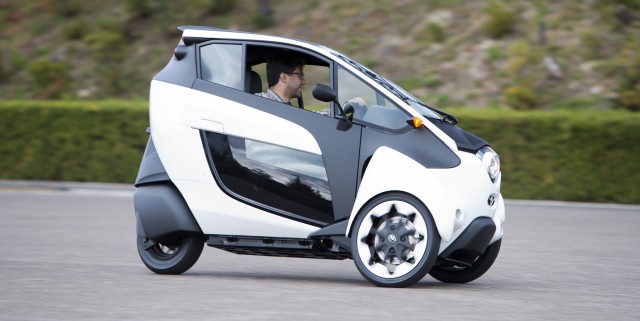
Tiny cars can’t literally afford to be prime innovators, but the Toyota i-Road is an exception to that rule.
This ’1+1′ seat three-wheeler is a brilliant, and genuine, glimpse at the future of city motoring – or at the very least, what it should be. Although a ‘concept’ at this stage, testing the i-Road at Toyota’s proving ground has revealed it could easily slip into production right now if government regulation and infrastructure were ready for it.
The i-Road certainly blurs the line between car and bike, but it seems to pinch the best bits from each form of transport. Indeed, Toyota states its main objective for the i-Road as blending the ease of use of a motorcycle with car-like stability and comfort.
The i-Road’s 870mm width is almost half that of the 1695mm Yaris. Importantly, the i-Road is 20mm thinner than the average large motorcycle, according to Toyota, and only 170mm wider than a scooter, so lane-splitting – whether encouraged, legal or not –is clearly possible.
It is also 2530mm long, so a rear passenger can at a squeeze sit behind the driver with legs splayed either side of the front seat.
Weighing 300kg, the i-Road gets twin 80mm-wide, 90-aspect 16-inch wheels at the front, and 1700mm further back to the rear wheel, a single 120mm-wide, 90-aspect 10-inch tyre.
The SRS airbag-embossed steering wheel with a Toyota logo in the middle is the only main reminder of a conventional car.
There’s a digital speedometer, P, N and D buttons to the left of the instrumentation, and hazard light and demister switches to the right of the flat grey plastic moulded dash.
A thin vinyl-trimmed front seat is reflective of the fact the i-Road is designed for short distance travel.
An electric motor and lithium-ion battery pack contribute to a 50km total range, and provide a top speed of 45km/h in Europe or 60km/h in Japan.
The way the i-Road gets up to speed, though, is impressive. Off the line, the instantaneous torque – Toyota won’t release full specifications – makes for perky throttle response and off-the-line speed.
Despite what seems like no sound deadening and perpex-glass doors and retractable door windows, the electric motor provides a smooth and, under full throttle, high-pitched whirring that is characterful and not unpleasant.
But the i-Road’s real party trick – and what makes it a real innovator – is its Active Lean System.
Yaw sensors around the i-Road connect to an actuator that ‘pushes’ down or ‘pulls’ up each of the two individual front dampers depending on the cornering attitude and road surface. It’s a bit like the technology found in Lancer Evolution X combined with the adaptive dampers found in most luxury cars, that can make the suspension harder or softer at the press of a button.
The i-Road actuator and suspension has to be more aggressive, though, because it only has three wheels. Toyota says that, unlike perhaps a Reliant Robin three-wheeler, the i-Road will never roll unless it goes off a cliff.
On an uneven surface at Toyota’s proving ground in Nagoya, Japan, the superb damping almost completely irons out one particular uneven drop in the road surface. The tiny little body simply stays flat, in the same way a Mercedes-Benz S-Class with Magic Body Control (MBC) would.
When cornering right, the actuator and yaw sensors pulls up on the left damper and pushes down on the right, to get the same attitude and lean as a motorcycle rider tipping into the same bend.
Despite precarious-looking cornering, the reality is anything but. The Active Lean System means the driver doesn’t feel cornering G-forces, only the body boogieing from side to side.
Therefore when the i-Road gets close to its cornering limits, the steering wheel buzzes to prevent the driver from overcooking it.
The fly-by-wire steering system turns only the rear tyre, renewing the term to ‘turn on a dime’ with a pivoting three-metre turning circle. The weighting and precision of the steering itself feels completely natural, astonishing for a system with no actual connection to the back wheel.
On the test track skidpan, the i-Road’s agility is superb, its handling playful and laugh-out-loud enjoyable. In this very car, Toyota president and keen driver Akio Toyoda’s directive to make all future models fun to drive is clearly evident.
In rainy and cold weather especially, the Toyota i-Road beats any scooter or motorbike. No helmet or special gear is needed, and it offers a fair bit more active and passive safety technology. Yet it can lane-split with them.
Thanks to zero-emissions electric-only driving, the i-Road can even be driven through your front door and into your house, solving dense city parking issues. In shopping centre car parks, four i-Roads can fit in one typical spot.
Best of all, the actuators and yaw sensors sound expensive, but Toyota claims they’re not. It isn’t talking pricing, but sub-$10,000 would be expected. For the practicality and parking benefits alone, the i-Road is worth whatever they ask. Comparing it with a conventional small car, meanwhile, is a bit like comparing an iPad mini to last millenium’s laptop…





